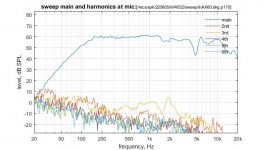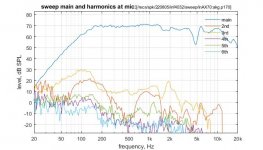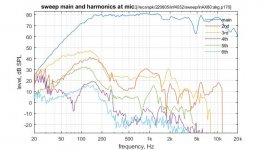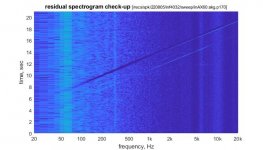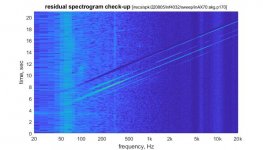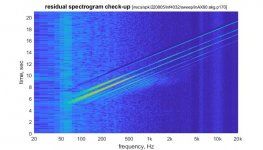And that's been my experience. If one is needing surgical precision to do edits, I don't want the room to get in the way. More direct sound, less reflections. Listening nearfield eg. 1-2m helps.
When I'm listening to music for enjoyment I'm several meters back.
I just want the experience of the sounds washing over me.
Lights out, no one else home, a glass of beverage helps too.
When I'm listening to music for enjoyment I'm several meters back.
I just want the experience of the sounds washing over me.
Lights out, no one else home, a glass of beverage helps too.
There is none.In practice, in real rooms, what is the ideal dispersion pattern?
However, there are some.
It heavily depends on the kind of room.
All we know is that is very desirable to have an even (constant) directivity.
To some extend I might add.
Because I still don't see why the directivity above say 8-10kHz would be very important, since the absorption above those frequencies is very significant.
Below 200Hz or so, room modes take over as well.
So we basically talking about the 200-9kHz range.
Anyway, so in a room with a lot of reverberation, it would not be advisable to use a sound source that has a low directivity index.
It also depends on the kind of sound stage you want.
With a higher directivity index (DI) the speaker will beam more, meaning less room reflections.
But it also means less spaciousness.
Less beaming means more spaciousness, but running the risk of more masking and smearing of the sound.
Which could potentially lead to less detail.
It also depends on how many listeners there are as well as how big the room is.
This is for home hifi not really a thing.
And sometimes you have to just make it work with what you got.
There are more variables and constraints than just pure "audio quality" (whatever that means).
The size of the cabinet for example or budgetary reasons.
In the end the only hifi that exist IS myfi.
We all have different preferences, ears, brains and rooms.
The only thing we can do is figure out what the average person/bulk prefers and use that information as a starting point.
Some approaches are (much) more likely to give a satisfying results than others.
Some people still seem to think that there is one solution fits all kind of thing.
When there are so many variables, that could obviously never work by definition.
I think dome midranges are to much of a niche.I’m starting to think the market moved away from the 3” dome for a reason…
Which is really hard to justify in sales and production.
These days a good speaker can be made with any decent performing cone speaker.
A 3" or 4" full-range/mid-range can either be used on it's own in a 2-way system or in a 3-way system.
While a dome midrange only has one purpose.
In practice, the amount of customers/client I know and have that like to go far a classic 3-way system are close to zero as well.
5 inch seems to be THE compromise for most people
A 15" pro woofer should not be in break up at 200 to 500Hz and if you look at the measurements of the driver itself it is not.
https://manualzz.com/doc/37151866/eds-9990013-jbl-2216nd
Almost the same driver used in the 4367 with a passive crossover looks much flatter in that region in Erin's measurements. Most 15" drivers have some wiggle in the 500Hz region from cone/surround issues.
The ~200Hz issue was cabinet related, IIRC. This is wrt the M2. I think I showed this by doing an impedance sweep with just the woofer out of the enclosure and then in the enclosure in my written review.
Also, note the driver used in the 4367 is different than the M2. The M2 uses the 2216nd. The 4367 uses the 2216nd-1. The main difference I recall is the breakup around 500Hz is better tamed in the -1 version. IOW, the 4367 uses a better driver wrt linearity.
726 it’s totally different driver. 1.8T, 93dB sensitivity, FS in this driver is 155Hz First Resonance Peak is around 9800Hz. BL ~11, Qts 0.41. It’s hard to describe but C90-6-724 was a first cell driver and was design to replace old models(close to old models sensitivity and enclosure). C90-6-726 it’s all new patch to cell concept. on my opinion and from measurement it’s different league. Lowest distortion ever from Accuton. Of course it’s harder to implement it well, because of more ringing(Due to much stronger motor).C90-6-724 is my favourite midrange from Accuton. The 726 perhaps is even more better than the 724
Maybe later this year will be possible to share measurements with you from final spherical cabinet, I can’t measure it for you in this moment due to lack of possibility.
Measure via Clio 12.5 with Earthworks QTC50 with QCBox V5.
Would be nice if a version is developed with a res freq of around 70 Hz726 it’s totally different driver. 1.8T, 93dB sensitivity, FS in this driver is 155Hz First Resonance Peak is around 9800Hz. BL ~11, Qts 0.41. It’s hard to describe but C90-6-724 was a first cell driver and was design to replace old models(close to old models sensitivity and enclosure). C90-6-726 it’s all new patch to cell concept. on my opinion and from measurement it’s different league. Lowest distortion ever from Accuton. Of course it’s harder to implement it well, because of more ringing(Due to much stronger motor).
Maybe later this year will be possible to share measurements with you from final spherical cabinet, I can’t measure it for you in this moment due to lack of possibility.
Measure via Clio 12.5 with Earthworks QTC50 with QCBox V5.
726 it’s totally different driver. 1.8T, 93dB sensitivity, FS in this driver is 155Hz First Resonance Peak is around 9800Hz. BL ~11, Qts 0.41. It’s hard to describe but C90-6-724 was a first cell driver and was design to replace old models(close to old models sensitivity and enclosure). C90-6-726 it’s all new patch to cell concept. on my opinion and from measurement it’s different league. Lowest distortion ever from Accuton. Of course it’s harder to implement it well, because of more ringing(Due to much stronger motor).
Maybe later this year will be possible to share measurements with you from final spherical cabinet, I can’t measure it for you in this moment due to lack of possibility.
Measure via Clio 12.5 with Earthworks QTC50 with QCBox V5.
Welcome Krzysztof!
Yes please share measurements of your customised Accuton driver. Even rough and ready ones are useful.
Hope things are going ok for you at Dearwolf Audio.
Concerning the earlier-discussed sub-topic of what might constitute an ideal dispersion pattern, correlated power response, and resulting increased consistency/balance between direct and reverberant radiation - as it's alleged to be of paramount importance by certain industry gurus and their devotees... here's the account of an interesting experiment which basically concludes that the "elephant in the room", as it were, is indeed the room itself (i.e. arbitrary reverberance/"second venue effect"/faux ambience-caused time-smearing/contamination of the pure direct radiation), and that quite literally taking the room altogether out of the equation results in more accurate reproduction (or perhaps just aspectually less inaccurate re-interpretation, which seems to be the best one can actually accomplish in this perpetually quixotic quest?):
https://augene.blogspot.com/2020/10/listening-in-anechoic-chamber.html
FWIW, a subsequent related thread on ASR:
https://www.audiosciencereview.com/...tening-in-an-anechoic-chamber-a-report.30274/
Or just listen outdoors, if/as one's domicile/local weather permits... in either instance, one gains as a side benefit quite a bit more freedom in mating drivers whose further-off-axis responses may not match up perfectly through the XO region, but which might otherwise be overall superior performers within their intended passbands, while also being concurrently able to eliminate the need for (baffle-space-consuming/vertical lobing exacerbating) waveguiding deployed in slavish devotion towards achieving the aforementioned "textbook" horizontal directivity matching.
The caveat is that tracks which were intentionally mixed/mastered on the very "dry" side (in anticipation of reverberance being added via the end user's listening space) might well wind up sounding a bit too far towards the "antiseptic" end of the spectrum...
As for the ongoing dome vs. cone debate, an exceptionally talented/diligent transducer engineer, who had been working on a 3" graphite ueber-dome mid (which, most disappointingly, his business partner ultimately voted against producing, in favor of their operation sticking exclusively to further expanding their excellent dome tweeter lineup), provided me (during the course of a conversation regarding said dome mid, which I was quite interested in as I prefer hard diaphragms - ruling out the ATC/Volt units - and there was at the time no such product being offered on the market until most recently by Bliesma with their M74A/B models) with a quick educational summary on the rather significant non-linearities and much-earlier-than-commonly-assumed breakup patterns of cone drivers, pointing out that, f.e., even "better" models in the 5" nominal diameter category cease to be accurately pistonic beyond around 800 Hz...
Very few commercial designers seem to concern themselves with these phenomena to where they ultimately take them into account in the design of their products; one well-known/respected exception in particular who does however subsequently crosses a very hi-res/hi-output-capable in-house-designed/manufactured 5" cone to an equally potent (non-waveguided) 2" dome "upper mid" @ 880, which in turn is crossed to a (non-waveguided as well) 1" tweeter - with a first breakup mode @ 45K, using "just" alu as the diaphragm material - @ 3.5K) in his company's 4-way top product line- only in his lower-grade 3-way models does he employ a 4" mid crossing to the aforementioned tweeter (in this instance surrounded by a waveguide so as to mitigate the directivity mismatch to the mid in the XO region - so a choice made not resulting from the designer's ultimate preference per se, but as a necessary compromise in a lesser-quality product which is sold at a far lesser price).
What's also peculiar (and ultimately perturbing) is that their suite of drivers manages to meld simultaneously pro-driver-style high sensitivity/power handling/output capacity AND proper hi-res-capable rigid diaphragms AND sufficient linear excursion - read: a complete combo, which the pundits (including popular driver manufacturers) continue to stubbornly insist can't all be had simultaneously... well quite apparently it actually can, (as, according to the designer himself, a SINGLE one of the above mentioned 5" units can crack 120db @ at a 220 Hz 4-th order highpass) - provided the requisite determination and competence are there to accomplish it, that is.
Meanwhile, those without the resources required to fund custom developments of such super-drivers are - most frustratingly - stuck with having to choose from countless flavors of mediocre/"me-too" off-the-shelf components - all of which invariably satisfy only a few aspects of the overall performance equation (do you want lifelike SPL levels from a non-horn-loaded direct-radiator - without being forced to build employ multiples in a line array -, or do you want hi-res refinement/accuracy which rapidly turns into serious distortion when listening beyond polite parlor-level peak SPLs?), - being perpetually served up by the "usual suspects" within the industry, all too often still sporting exorbitant price tags no less .
Once in a blue moon, a truly refreshing beast like the T34B comes along, bringing genuine innovation and exceptional performance in ALL categories to the table, which arguably justifies its non-trivial cost... the M74B looks like it might just qualify as well, but a bit more real-world-usage-based feedback might yet be required for final confirmation... if indeed yes, then the two together could provide a potent upper mid/HF 1-2 punch in a - yes, still arbitrary like everything else, but nonetheless acceptable compromise that's actually worth constructing...
https://augene.blogspot.com/2020/10/listening-in-anechoic-chamber.html
FWIW, a subsequent related thread on ASR:
https://www.audiosciencereview.com/...tening-in-an-anechoic-chamber-a-report.30274/
Or just listen outdoors, if/as one's domicile/local weather permits... in either instance, one gains as a side benefit quite a bit more freedom in mating drivers whose further-off-axis responses may not match up perfectly through the XO region, but which might otherwise be overall superior performers within their intended passbands, while also being concurrently able to eliminate the need for (baffle-space-consuming/vertical lobing exacerbating) waveguiding deployed in slavish devotion towards achieving the aforementioned "textbook" horizontal directivity matching.
The caveat is that tracks which were intentionally mixed/mastered on the very "dry" side (in anticipation of reverberance being added via the end user's listening space) might well wind up sounding a bit too far towards the "antiseptic" end of the spectrum...
As for the ongoing dome vs. cone debate, an exceptionally talented/diligent transducer engineer, who had been working on a 3" graphite ueber-dome mid (which, most disappointingly, his business partner ultimately voted against producing, in favor of their operation sticking exclusively to further expanding their excellent dome tweeter lineup), provided me (during the course of a conversation regarding said dome mid, which I was quite interested in as I prefer hard diaphragms - ruling out the ATC/Volt units - and there was at the time no such product being offered on the market until most recently by Bliesma with their M74A/B models) with a quick educational summary on the rather significant non-linearities and much-earlier-than-commonly-assumed breakup patterns of cone drivers, pointing out that, f.e., even "better" models in the 5" nominal diameter category cease to be accurately pistonic beyond around 800 Hz...
Very few commercial designers seem to concern themselves with these phenomena to where they ultimately take them into account in the design of their products; one well-known/respected exception in particular who does however subsequently crosses a very hi-res/hi-output-capable in-house-designed/manufactured 5" cone to an equally potent (non-waveguided) 2" dome "upper mid" @ 880, which in turn is crossed to a (non-waveguided as well) 1" tweeter - with a first breakup mode @ 45K, using "just" alu as the diaphragm material - @ 3.5K) in his company's 4-way top product line- only in his lower-grade 3-way models does he employ a 4" mid crossing to the aforementioned tweeter (in this instance surrounded by a waveguide so as to mitigate the directivity mismatch to the mid in the XO region - so a choice made not resulting from the designer's ultimate preference per se, but as a necessary compromise in a lesser-quality product which is sold at a far lesser price).
What's also peculiar (and ultimately perturbing) is that their suite of drivers manages to meld simultaneously pro-driver-style high sensitivity/power handling/output capacity AND proper hi-res-capable rigid diaphragms AND sufficient linear excursion - read: a complete combo, which the pundits (including popular driver manufacturers) continue to stubbornly insist can't all be had simultaneously... well quite apparently it actually can, (as, according to the designer himself, a SINGLE one of the above mentioned 5" units can crack 120db @ at a 220 Hz 4-th order highpass) - provided the requisite determination and competence are there to accomplish it, that is.
Meanwhile, those without the resources required to fund custom developments of such super-drivers are - most frustratingly - stuck with having to choose from countless flavors of mediocre/"me-too" off-the-shelf components - all of which invariably satisfy only a few aspects of the overall performance equation (do you want lifelike SPL levels from a non-horn-loaded direct-radiator - without being forced to build employ multiples in a line array -, or do you want hi-res refinement/accuracy which rapidly turns into serious distortion when listening beyond polite parlor-level peak SPLs?), - being perpetually served up by the "usual suspects" within the industry, all too often still sporting exorbitant price tags no less .
Once in a blue moon, a truly refreshing beast like the T34B comes along, bringing genuine innovation and exceptional performance in ALL categories to the table, which arguably justifies its non-trivial cost... the M74B looks like it might just qualify as well, but a bit more real-world-usage-based feedback might yet be required for final confirmation... if indeed yes, then the two together could provide a potent upper mid/HF 1-2 punch in a - yes, still arbitrary like everything else, but nonetheless acceptable compromise that's actually worth constructing...
The review of the PURIFI Alu cone long-stroke midwoofer PTT6.5X04-NAA-08:
https://hificompass.com/en/reviews/purifi-ptt65x04-naa-08-65-alu-midwoofer
Yes, and this makes it difficult to decide, which is the right Purifi driver for a specific application.Its hard to think it could get any better from here. But I'm sure they'll find a way.
Though this driver seems to be intended to be used as a real midwoofer, its performance in the midrange is so excellent, that it probably can compete with the dedicated midrange driver PTT6.5M as a pure midrange.
Hard to say, which will sound better.
I read the reviews of both drivers very carefully, but I would be very interested in a direct comparison.
Did anybody make a direct listening comparison of both drivers? What is similar and what is different soundwise?
I'm especially interested in finding the best Purifi driver for an open baffle midrange. But every opinion and experience is highly appreciated
Hi Krzysztof, Any news on this new accuton?726 it’s totally different driver. 1.8T, 93dB sensitivity, FS in this driver is 155Hz First Resonance Peak is around 9800Hz. BL ~11, Qts 0.41. It’s hard to describe but C90-6-724 was a first cell driver and was design to replace old models(close to old models sensitivity and enclosure). C90-6-726 it’s all new patch to cell concept. on my opinion and from measurement it’s different league. Lowest distortion ever from Accuton. Of course it’s harder to implement it well, because of more ringing(Due to much stronger motor).
Maybe later this year will be possible to share measurements with you from final spherical cabinet, I can’t measure it for you in this moment due to lack of possibility.
Measure via Clio 12.5 with Earthworks QTC50 with QCBox V5.
Member
Joined 2003
The only consideration I see is sensitivity and xmax. Do you need the extra sensitivity of the dedicated midrange to work with your woofers? If the answer is no, either driver will perform admirably for the task, ie the performance of your speaker will be more dependent on other factors like filter design, baffle design, etc than the choice between these two drivers.Yes, and this makes it difficult to decide, which is the right Purifi driver for a specific application.
Though this driver seems to be intended to be used as a real midwoofer, its performance in the midrange is so excellent, that it probably can compete with the dedicated midrange driver PTT6.5M as a pure midrange.
Hard to say, which will sound better.
I read the reviews of both drivers very carefully, but I would be very interested in a direct comparison.
Did anybody make a direct listening comparison of both drivers? What is similar and what is different soundwise?
I'm especially interested in finding the best Purifi driver for an open baffle midrange. But every opinion and experience is highly appreciated
I never understand what people mean with "better" ?
If money is not problem and you don't mind the look of the speaker, just go for it yes.
I don't really see why people would need a "listening comparison" for these things?
For a speaker that barely distorts, there is not much except a badly designed implementation and/or filter that would make sound such a speaker sound "bad". Since all other variables are basically gone.
That also counts for any other speaker that is being used in region where no significant problems occur.
If money is not problem and you don't mind the look of the speaker, just go for it yes.
I don't really see why people would need a "listening comparison" for these things?
For a speaker that barely distorts, there is not much except a badly designed implementation and/or filter that would make sound such a speaker sound "bad". Since all other variables are basically gone.
That also counts for any other speaker that is being used in region where no significant problems occur.
Matty probably needs some tips/advise to aid his purchase decision.
My question is what are you trying to design?
That will help narrow down your choices?
It’s tempting to choose the driver first and around that. But it’s better to start with a general question, like “what is the application, or typical use case of this speaker?”
Outdoors or indoors?
If outdoors how many people (100/1K/10K/100K)?
If indoors size of room?
In that room- What’s the typical listening distance?
Listening at live or “life-like” levels (music) or movie theatre levels?
My question is what are you trying to design?
That will help narrow down your choices?
It’s tempting to choose the driver first and around that. But it’s better to start with a general question, like “what is the application, or typical use case of this speaker?”
Outdoors or indoors?
If outdoors how many people (100/1K/10K/100K)?
If indoors size of room?
In that room- What’s the typical listening distance?
Listening at live or “life-like” levels (music) or movie theatre levels?
Hi @tktran303 ,
yes, I asked this question (among other reasons), because I'm considering a change in my system, which could include one of these Purifi 6.5 drivers. I have open baffle speakers and I'm considering to use the Purifi from somewhere between 300-600Hz up to ca. 2000Hz, depending on how it performs in real life and how it integrates into the system.
But I'm asking this question also out of curiosity.
Purifi is offering several extremly good drivers, which, considering the specs, mainly differ in terms of xmax, sensitivity and how they behave in the breakup area.
And maybe step response (which of course also reflects the breakup behaviour).
So, is the decision, which driver will be best really reduced to xmax vs. sensitivity, when using them in their 'comfort zone'?
On the other hand, @HiFiCompass is describing his listening impressions in his reviews for the tested drivers, e.g.
This is why I'm wondering, if I could expect any differences between the PTT6.5M and the PTT6.5X04-NAA,when used within their specs and in the same way.
yes, I asked this question (among other reasons), because I'm considering a change in my system, which could include one of these Purifi 6.5 drivers. I have open baffle speakers and I'm considering to use the Purifi from somewhere between 300-600Hz up to ca. 2000Hz, depending on how it performs in real life and how it integrates into the system.
But I'm asking this question also out of curiosity.
Purifi is offering several extremly good drivers, which, considering the specs, mainly differ in terms of xmax, sensitivity and how they behave in the breakup area.
And maybe step response (which of course also reflects the breakup behaviour).
So, is the decision, which driver will be best really reduced to xmax vs. sensitivity, when using them in their 'comfort zone'?
On the other hand, @HiFiCompass is describing his listening impressions in his reviews for the tested drivers, e.g.
Compared to the long-stroke PTT6.5X08-NFA-01 midwoofer, the midrange driver sounds more open and easy in the upper midrange, with better reproduction of the acoustic atmosphere of the hall and many of the nuances that were heard in the midwoofer somewhere in the background and less expressive.
This is why I'm wondering, if I could expect any differences between the PTT6.5M and the PTT6.5X04-NAA,when used within their specs and in the same way.
Matty
Are you trying to replace a driver in your current open baffle speaker?
Or a clean state design?
It is intended to replace a driver in my current setup.
Actually it should replace 2 drivers.
My current setup:
Acoustic Elegance Dipole18 20-80Hz
BDDesign BD15 (Beyma OEM) 80-800Hz
Scanspeak 12MU 800-2.100Hz
Mundorf 25D1.1 800-20.000Hz
All actively controlled by Acourate with FIR filters.
I love my current system and it really works great, but for several (non-technical) reasons, I would like to downgrade a little bit.
3-way would be perfect and should be possible without to much compromise.
And I think Purifi drivers are the perfect choice.
The Dipole18 can go much higher, than in my current setup.
And with FIR filters, it is possible to start with the Mundorf a little bit lower.
Doing this, removing the BD15 and the 12MU and using a Purifi PTT6.5 instead could be a nice system
And now I'm wondering which Purifi driver fits best.
Simulations with 'The Edge' show, that - with the right baffle - it should be possible to keep a very good horizontal directivity.
But as already mentioned, I would be interested in your experiences independent from my plans
P.S.: I used this thread, because @HiFiCompass not only measured, but also detailly reviewed both drivers, including a description of his listening impressions and usage recommendations
Last edited:
I don't know if you take requests, but full measurements of both the HiVi L6-6R and L6-4R would be great. Both are inexpensive, and in my experience the L6-4R is a solid performer in both the midrange and bass. I'd be curious what a third party would have to say about them. I kinda want to stack a few of the 6R's as a bass tower underneath my mains, but don't trust the company spec.
- Home
- Loudspeakers
- Multi-Way
- Some speaker driver measurements...
